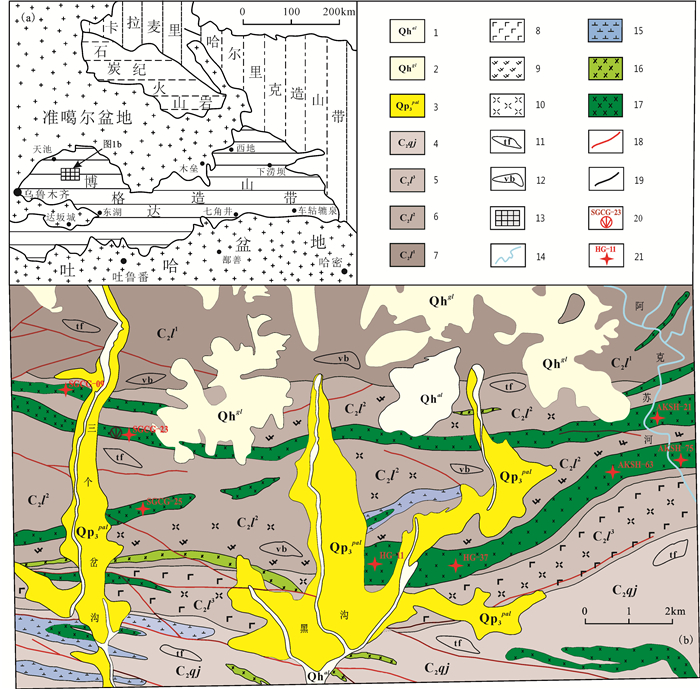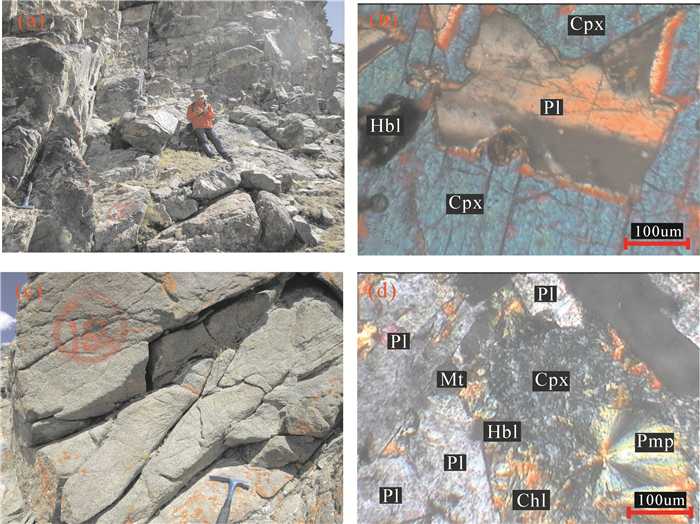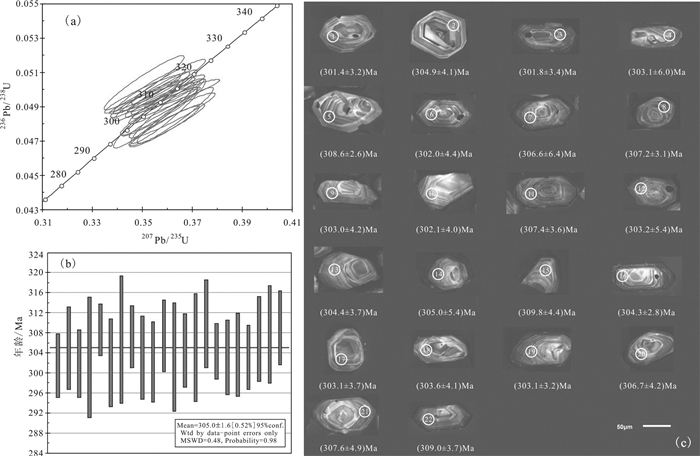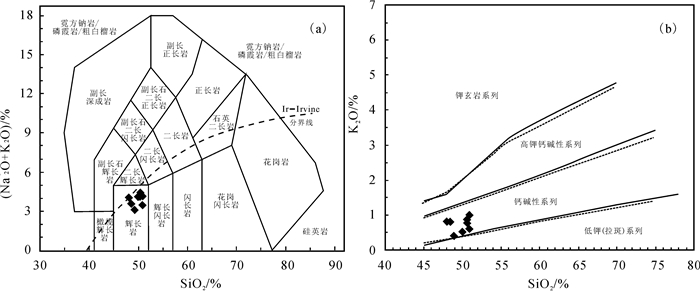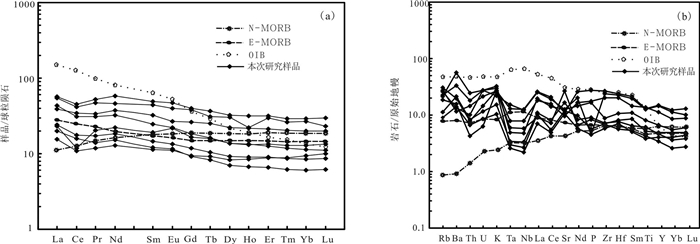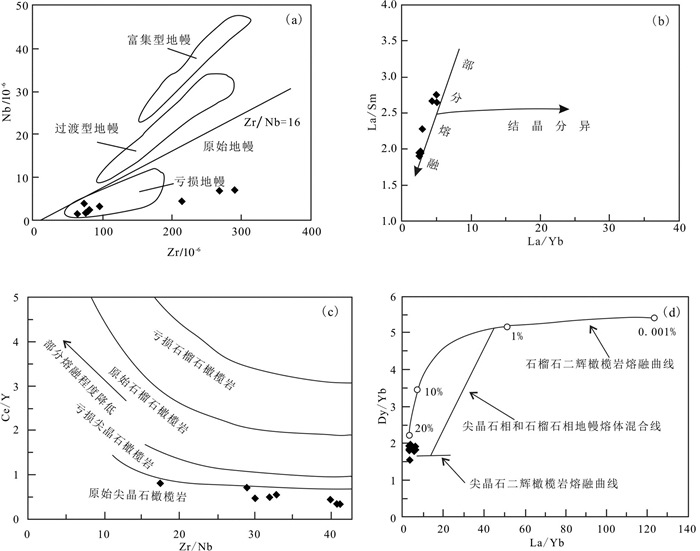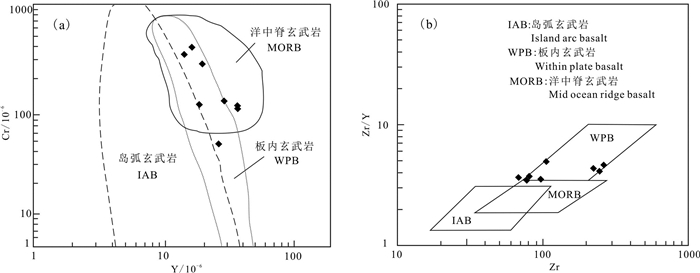The Carboniferous tectonic attributes of the Bogda orogenic belt in Xinjiang: Evidence from gabbro chronology and geochemistry
-
摘要:
博格达造山带广泛分布着基性侵入岩体,其成因对正确认识该区地球动力学背景具有重要意义。鉴于此,本文对位于博格达造山带西段的辉长岩进行了岩石学、地球化学及锆石U-Pb年代学研究,探讨其岩石成因及构造属性,以期为解决博格达造山带的地质构造演化提供依据。岩石地球化学分析结果显示,辉长岩SiO2含量介于48.08%~51.03%,全碱(ALK)含量为3.09%~4.39%(小于5%),富CaO(6.87%~11.41%)、贫Al2O3(12.59%~18.49%),MgO含量介于3.78%~7.66%,Mg#值为31.75~65.73(均值为47.03),铝饱和指数值(A/CNK=0.60~0.80),属准铝质中钾钙碱性岩石系列。岩石稀土元素含量较低(36.30×10-6~147.72×10-6),轻重稀土之间以及轻重稀土内部不存在明显的分馏过程;微量元素中Th、Ta、Nb元素明显亏损,Ti元素亏损不明显以及U元素的轻微富集,具大陆裂谷岩浆活动特点。根据有关微量元素、稀土元素的相关图解比值,指示该区辉长岩岩浆源于亏损的岩石圈地幔,侵位过程中受到了地壳物质的混染,分异演化程度较低,为原始尖晶石相橄榄岩较高程度的部分熔融,形成于板内裂谷环境。此外,辉长岩LA-ICP-MS锆石U-Pb定年结果表明,其形成时代为(305.0±1.6)Ma(晚石炭世末期),处于博格达裂谷火山活动期晚期,为博格达西段裂谷作用由全面伸展向局限伸展转换的标志。综合区域地质资料分析,认为晚古生代期间(早石炭世—早二叠世),博格达造山带存在大面积的与裂谷演化有关的岩浆活动,造山带是在裂谷基础上发展起来,其形成与康古尔塔格洋推动着准噶尔—吐哈地块向北俯冲作用有关。
Abstract:Basic intrusive rock masses are extensively developed in Bogda orogenic belt, and their origin is of great significance to the correct understanding of the geodynamic background of this area. In this paper, the authors studied systematically petrology, geochemistry and zircon U-Pb geochronology of gabbro in the west of Bogda orogenic belt, in order to discuss their petrogenesis and tectonic significance and then to provide a basis for solving geological tectonic evolution of Bogda orogenic belt. Petrogeochemical analysis shows that their SiO2 values range from 48.08% to 51.03%, and ALK values range from 3.09% to 4.39% (less than 5%), and that they are rich in CaO (6.87%-11.41%), and depleted in Al2O3 (12.59%-18.49%). The MgO values range from 3.78% to 7.66%, Mg#=31.75-65.73 (47.03 on average), and A/CNK=0.60-0.80, indicating that the rocks belong to metaluminous intermediate K calc-alkaline rock series. The analysis also shows that they have low REE (36.30×10-6-147.72×10-6), with no obvious fractionation between light and heavy rare earth elements and between heavy rare earth elements. They are obviously depleted in Th, Ta, Nb elements, with no obvious loss of Ti and slight enrichment of U element, showing the characteristics of continental rift magmatism. According to the relevant diagram and the ratio of trace elements and rare earth elements, the gabbro magma probably originated from depleted lithospheric mantle, with the contamination of the crust; their differentiation evolution degree was low; they experienced higher degree of partial melting of the original phase spinel peridotite, and were formed in the intraplate rift environment. Moreover, gabbro LA-ICP-MS zircon U-Pb dating results show that the formation age is (305.0±1.6) Ma, suggesting the late period of the Bogda rift volcanic activity in late Carboniferous. All these data indicate that the west of Bogda rift underwent a conversion from the overall extension stage to the confined extension stage. The analysis of regional geological data shows that there existed a large rift evolution related to magmatism during Late Paleozoic (Early Carboniferous-Early Permian), and the orogenic belt was developed on the basis of rifting, with its formation related to the northward subduction of the Junggar-Turpan-Hami block driven by the Kangurtag Ocean.
-
Keywords:
- gabbro /
- geochemistry /
- zircon U-Pb dating /
- continental rift /
- geological survey engineering /
- Bogda orogenic belt
-
1. 引言
机载高光谱成像是一种新兴技术,它是一种快速、无损的检测技术,具有光谱分辨率高、波段多和图谱合一的特点。自从1982年美国航天局喷气推进实验室(Jet Propulsion Laboratory,JPL)研制出第一台机载成像光谱仪(AIS-1)并获取遥感飞行数据以来,高光谱遥感的出现为遥感技术带来一场革命。而后包括中国在内的许多国家都研制成功了一系列高光谱遥感设备,开展对地观测和空间目标探测任务,搭载于卫星平台、车载平台(月球车、火星车等)和航空平台。进入21世纪以来,机载高光谱应用发展出现井喷态势,高光谱仪器性能的提高、功能的日益完善和高光谱数据快速、准确、自动化的分析处理,使得机载高光谱日益得到行业重视,广泛应用于地质调查、环境监测、精准农业、海洋观测、土地质量和城市规划等领域(张宗贵等,2000;甘甫平,2004;王润生等,2010)。
作为光谱细分遥感成像技术,光谱成像仪研制朝着高光谱、高空间分辨率和微型化轻量化发展。目前国外商业化的光谱成像仪有3种:光机扫描型、推扫型和凝视型(郑志忠等,2017;郑志忠等, 2020a, b)。以澳大利亚的HyMap为代表的光机扫描型机载成像仪,成为国内外高光谱行业应用的主打仪器。推扫型成像光谱仪有加拿大的CASI,芬兰的SPECIM、挪威的AISA和美国的Headwall成像光谱仪(郑志忠等, 2020b, c)。凝视型成像光谱仪有美国CRI的液晶可调谐成像光谱仪Varispec。国内小型化的机载高光谱仪器依赖进口,价格昂贵,且高性能的高光谱设备进口困难,限制了高光谱技术在国内的普及和推广应用。
近些年来,在可见光-近红外(400~1000 nm)和短波红外(1000~2500 nm)波段范围的高光谱成像仪研制方面,国内取得长足进步,优势单位包括上海技术物理研究所、长春光机所和中国地质调查局南京地质调查中心等。从20世纪80年代开始,上海技物所研制出OMIS高光谱成像系统,深圳中达瑞和科技有限公司研制了液晶可调谐滤波器(LCTF),基于LCTC的成像光谱仪SHIS等。中国地质调查局南京地质调查中心在国家重大仪器开发专项和国家重点研发计划支持下,成功研制了以推扫式小型化成像光谱仪HMS400/1000为核心的轻型机载高光谱成像系统SSMap(魏桂华等,2019),已在江苏、安徽、浙江等地进行了生态地质环境调查应用示范,取得了高质量的机载遥感数据,获得了一批重要调查成果。
2. 机载高光谱基本原理及其应用领域
2.1 基本原理
机载高光谱波段通常工作在400~2500 nm(0.4~2.5 μm)范围内,由可见光和近红外两个谱段组成,可见光谱段为400~780 nm(0.4~0.78 μm),主要用于区分岩心颜色、植被、水体等;近红外光谱的波长在780~2500 nm(0.78~2.5 μm),主要用于区分含羟基的物质,对此波段的近红外光谱产生吸收的官能团主要是含氢基团,包括C-H (甲基、亚甲基、甲氧基、羧基、方基等)、羟基O-H、巯基S-H、氨基N-H等,它们的合频和一级倍频位于780~2500 nm波段。由于含有羟基物质晶格中原子间的化学键的弯曲、伸缩和电子能级跃迁吸收某些区域的近红外光谱,所以根据某些官能团的在近红外区域的这种特征吸收光谱可以区分不同的物质(修连存等,2007)。
2.2 应用领域
随着机载高光谱遥感技术的发展,数据处理方法成熟,广泛应用于地质调查、环境监测、海洋生态评价、土地质量评估、精准农业、林业生态和城市规划领域(Berger et al., 2003)。在地质调查领域中,利用机载高光谱遥感具有空间分辨率高,能够精确反映地物目标这一特质,可以区分层状硅酸盐中单矿物(黏土矿物,绿泥石,蛇纹石等),含羟基之硅酸盐矿物(绿帘石,闪石等),硫酸盐矿物(明矾石,黄铁钾矾,石膏等),碳酸盐矿物(方解石,白云石等);而矿物种类揭示矿化作用过程中热液蚀变体系结晶时的温度、压力和化学环境,矿物中的离子交换反映在羟基的波长移动上,矿物的含量反映在羟基的吸光度上,这些参数揭示地质事件和成矿规律(修连存等,2009)。在环境监测领域,可迅速识别植物、建筑、水质、道路、湿地、土壤等分布与面积,通过建模,评价水土环境质量、农田作物长势和病虫害等。
高光谱遥感具有图谱合一的特点(图 1),避免了以往航摄带来的弊端,它不仅能够用图像表达目标,还可以根据光谱识别目标,利用高光谱遥感技术,能够高效地对长江经济带生态环境、经济发展和城镇布局进行评价,为政府规划和治理提供技术服务。
3. 机载高光谱成像系统SSMap研发及参数指标
3.1 系统研发
SSMap采用中国地质调查局南京地质调查中心自主研发的VRIN可见光-近红外高光谱成像仪与SWIR短波红外高光谱成像仪(图 2)进行机载航空高光谱测量系统集成(图 3~图 5),并研发了配套的软件对机载高光谱遥感数据进行预处理与信息提取。
![]() 图 3 有人机系统组成(a)和无人机系统组成(b)1—姿态传感器;2—短波红外成像光谱仪;3—可见光成像光谱仪;4—稳定平台;5—诺瓦泰惯性导航仪;6—支撑架;7—三轴稳定平台;8—短波红外成像光谱仪Figure 3. The composition of the manned vehicle system (a) and the composition of the UAV system (b)1- Attitude sensor; 2- Short- wave infrared imaging spectrometer; 3- Visible light imaging spectrometer; 4- Stable platform; 5- Novartis inertial navigator; 6-Support frame; 7-Three-axis stabilized platform; 8-Short-wave infrared imaging spectrometer
图 3 有人机系统组成(a)和无人机系统组成(b)1—姿态传感器;2—短波红外成像光谱仪;3—可见光成像光谱仪;4—稳定平台;5—诺瓦泰惯性导航仪;6—支撑架;7—三轴稳定平台;8—短波红外成像光谱仪Figure 3. The composition of the manned vehicle system (a) and the composition of the UAV system (b)1- Attitude sensor; 2- Short- wave infrared imaging spectrometer; 3- Visible light imaging spectrometer; 4- Stable platform; 5- Novartis inertial navigator; 6-Support frame; 7-Three-axis stabilized platform; 8-Short-wave infrared imaging spectrometer系统由成像光谱仪、三轴稳定平台、惯性导航仪和计算机控制与采集模块等多个部分组成。
3.2 主要技术参数
表 1 小型成像光谱仪参数Table 1. Parameters of the small-size imaging spectrometer 表 2 惯导定位精度参数Table 2. The INS positioning accuracy parameters
表 2 惯导定位精度参数Table 2. The INS positioning accuracy parameters
3.3 数据处理软件研发
机载高光谱数据具有数据量大、处理过程复杂等特点,因此需要高性能的服务器电脑和专业的处理软件。硬件部分由多台高性能戴尔服务器电脑组成的运算系统,其服务器操作系统性能稳定,计算能力强,使数据处理工作得到了可靠保障。机载高光谱数据处理采用NovAtel的IE8.8软件进行Pos数据后差分解算,采用自主研发的HyperPic软件进行光谱数据处理,包括飞行规划、大气校正、几何校正、辐射定标和反射率反演等功能(Bierwirth et al., 2002)。
4. 机载高光谱数据采集流程与方法
4.1 系统安装及检查
飞行前将仪器设备安装在固定翼飞机、直升机或者无人机等平台上。检查系统外观是否有意有磕、碰和摔等情况。检查测量系统及其配套设备、地面测量基站等工作状态是否正常,确保系统各个部分组装牢固安全。电源、电缆连接正确无误,各仪器设备读数正常。进行光谱成像仪的数据采集测试,保证设备工作正常。进行惯性导航仪检查,确保GPS导航定位接收信号良好,通讯系统保持畅通。对系统进行干扰测试,保证数据收录正常。
4.2 野外数据采集
航空数据采集作业流程包括现场踏勘、飞行准备、飞行测量和地物测量。
飞行前,工作小组需对测区边缘和测区内进行现场踏勘,熟悉测区的地形地貌,对于地形复杂不容易达到的测区,通过地形图进行了解,确定地面测量基站和像控点的布设选址。通过调研,确定最佳机场,制定应急迫降方案。
飞行准备包括:收集气象资料,了解适航天气;收集测区内的地图并扫描成电子版;地图裁切,输入角坐标,进行地图定位,作为飞行导航底图;由专业机组人员对飞机及成像系统进行飞行前例行检查,检查飞机安全状况,成像系统的各接口及仪器性能稳定性进行调试监测和评估。
在飞行测量中,飞机引擎启动后,接通电源,启动仪器设备,检查设备状态是否正常,并按照设计要求,设置相关技术参数。起飞后,打开镜头窗口遮挡板。进入测线前2 km开始记录数据,并于飞出测线2 km后停止记录数据,检查记录状态,监测仪器状态,根据信号强弱调整相关参数。操作人员要时刻监测航迹、航高、航速是否符合要求,同时监测气象条件(云量、能见度),填写飞行记录表。如不符合设计要求,及时进行补飞,补飞按原设计要求进行。飞行结束后,根据机上定位设备的需要,在静止状态下收集满足定位要求的数据后,关闭仪器,备份数据,为下一架次测量存储做好准备。
地面数据的获取主要包括GPS地面基站测量、地面光谱采样、水样采集等三个部分,在航飞数据采集的同时,地面同步进行测量工作。
4.3 GPS地面基站测量
使用地面卫星导航定位基站数据做后差分计算,在飞行前30 min打开地面基站,在卫星导航定位基站搜索卫星成功后(至少8颗卫星),采用静态测量模式记录数据,数据记录频率高于1 Hz。飞行结束半小时后停止记录,关闭地面基站,导出基站数据并备份。
4.4 光谱采样及采样点定位
地面光谱采样采用宽谱段地物波谱仪(350~2500 nm),采样点定位采用中海达iRTK2型号设备和江苏Cors定位系统,定位精度达厘米级。作业需要获取航空组规划好的飞行路线图,根据飞行路线图,设计地面定标路线。选择地面定标路线要求兼顾飞行路线条件与地面地物条件,每条航线范围内有至少一个地面采样点,每个采样点采样的地物种类数量视具体情况确定,在确保时间足够的情况下,尽量多采地物光谱。在地面道路条件允许的情况下,尽量使定标路线垂直或近似垂直地斜交航线,保证每条航线地面采样时间与飞行时间相差不大。在符合以上基本条件的地面路线中,选取沿途地物种类丰富,房屋建筑物遮挡较少,便于采样作业的地面路线。飞行测量过程中,地面光谱采样工作同步进行,并记录采集点位置、时间和对应的架次及航带,测量完成后,备份光谱数据和定位数据(荆平平等,2017;孙家波等,2018;蔡祥等,2021)。图 6为采集的几种典型地物地面光谱曲线。
4.5 水体样采集及现场测试
采样前要根据检测项目的性质和采样方法要求,选择适宜材质的盛水容器和采样器,并充分清洗干净(李鑫星等,2021)。此外,还要准备好适当的交通工具。采样容器一般使用塑料容器或玻璃容器。塑料容器用作测定金属、放射性元素和其他无机物的盛水容器,玻璃容器则用作测定有机物和微生物等的盛水容器。有些项目要求提前加入保存剂,不同项目加入保存剂不同,根据保存剂的不同分别准备盛水容器。同时还准备一些采样的工具,比如水桶,采样器,现场使用的实验设备:pH计、温度计等。在采集河流、湖泊等地表水时,可以使用桶、瓶等容器直接采取。一般将其沉至水面下0.3~0.5 m处采集。在桥上等地方采样时,可将系着绳子的聚乙烯桶或带着坠子的采样瓶投于水中汲水,要注意不能混入漂浮于水面上的其他物质。采集深层水样时,可以使用带重锤的采样器。测定溶解氧的水样,要使用专门的双瓶采样器采样。湖泊、水库的采样点应该设置在湖水的主要出入口、中心区、沿湖泊(水库)水流方向、滞留区及湖边城市水源区(罗代洪等,2004;甘露等,2010;崔齐等,2018)。大部分水样在当天采样工作完成后,立即送往专业分析机构进行测试,测试的指标见表 3。
表 3 水常规化验指标(水质参数)一览Table 3. List of water routine test indexes
5. 高光谱数据处理与信息提取
5.1 高光谱数据预处理
高光谱机载平台获取数据时,由于平台高度及光谱仪视场角限制,导致数据获取幅宽有限,需多架次飞行获取的多航带数据才能完整覆盖研究区域(王瑞军等,2020)。因此机载高光谱数据预处理包括辐射校正、几何校正和图像拼接等工作,以获得在空间和辐射能量探测上的精准匹配的完整研究区域影像。最后通过同步获取的地物波谱数据验证影像的辐射精度,以进一步检验成像数据质量。
5.1.1 辐射定标
由于成像光谱仪输出的数据并不具有物理意义,因此通过辐射定标将成像光谱仪的DN值转为有物理意义的辐射亮度值,使遥感信息定量化。采用积分球系统(图 7)完成成像光谱仪的辐射定标。
通过对比积分球能级数据即对应功率、积分时间下输入的辐射亮度值与光谱仪输出DN值之间的关系,逐波段进行线性拟合,完成光谱仪的辐射定标。
在辐射定标前需要对积分球辐亮度数据进行线性插值,得到光谱仪的各波段所对应的辐亮度值。影像DN值与辐亮度值之间存在着线性关系,通过求解高光谱影像的各波段增益系数以及偏移量,完成影像数据的辐射定标(Moamen et al., 2021)。图 8和图 9为可见光影像和短波红外影像辐射定标后的光谱变化。
5.1.2 反射率转换
在经过辐射定标后,求得辐亮值数据,进一步使用经验线性法进行反射率转换,参与反射率转换的地面同步光谱数达到324条,平均每一条航带2条以上的同步地物波谱。
基于经验模型的反射率反演算法,主要是应用图像像元自身的灰度值,不考虑大气、地物属性以及遥感平台特征,通过对象元灰度值进行求均值或回归运算,在统计意义上获得图像的反射率值(孙雨等,2015)。
经验线性法(Empirical Line, EL)已经在遥感定标和反射率反演中被广泛使用,主要依靠图像象元值和图像背景信息之间的拟合关系(Ben-Dor et al., 2004)完成地表反射率的反演计算。经验线性法基于如下简化的公式:

(1) 其中:DNb为给定象元在波段b的数字量化值;ρ(λ)为实测地物象元在波段b所在的波长的地表反射率值;Ab为由于传输和仪器本身所导致的倍数增益系数;Bb为由于大气程辐射和仪器导致的偏移。
该方法在应用中, 一般会实测地面两个或多个定标点的地面反射光谱数值(reflectance spectra),然后计算遥感图像上对应象元点的平均辐射光谱值, 通过使用统计学中的回归运算,得到公式(1)中的增益值Ab和偏移值Bb,最后应用该公式,对整幅遥感图像进行反射率的计算。其中某一地物波谱反射率与地面波谱反射率对比如图 10。
5.1.3 几何校正
首先进行IMU/GPS数据处理,Pos数据采用诺瓦泰公司的IE8.8软件进行处理(图 11)。该软件一般可以采用精密单点定位PPP和基站两种方式解算POS数据,本次采用基站后差分处理方式解算POS数据,精密计算每行数据于曝光时刻的机载GPS天线相位中心的WGS84框架坐标和姿态参数。
在完成POS数据的解算后进行插值处理,得到了高光谱影像各个扫描行所对应的外方位信息,可以通过建立旋转矩阵进行坐标转换,将导航坐标转换为投影坐标。具体坐标的转换过程如下:成图坐标系(m)→导航坐标系(g)→IMU坐标系(b)→传感器坐标系(c)→像空间坐标系(i),由成图坐标系转换至像空间坐标系的旋转矩阵表达形式如下:

(2) 式中旋转矩阵可由已知条件观测获取,通过矩阵变换求得三个外方位元素姿态参数[(ω, ϕ, κ)],三个外方位元素位置参数[(Xs, Ys, Zs)]需要考虑IMU坐标系中的坐标位置偏移[(Xt, Yt, Zt)]进行修正。

(3) 在求得所有外方位元素[(ω, ϕ, κ, Xs, Ys, Zs)]后,根据共线条件方程,采用直接法几何校正计算像点坐标[(x, y)]对应的地面点坐标[(X, Y, Z)],并赋予其像点对应的灰度值。坐标变换公式为:

(4) 粗校正后的影像,精度还存在一定的误差,本实验利用采集的像片控制点对所有有效的像片均进行微分纠正。按照航带分区域纠正,最后通过镶嵌过程,得到最终高光谱影像。
5.2 地物分类与信息处理
工作中采用可见光数据287个波段进行地物的精细分类。光谱分辨率和空间分辨率分别为2.42 nm和1.0 m。地面光谱采样主要包含各类农作物和树木、草地、道路材质等68个地物类别,根据工区内地物存在的实际情况,仅选取了农作物、树木、草、水生植物、道路材质、建筑、裸露地表等七大类别,共计46种地物种类进行精细分类,具体如表 4。工区内的其他地物由于数量较少或者光谱干扰严重无法区分,如构树、枣叶、茶树、银杏、豇豆、葡萄、芒草、花岗岩地砖等,其中建筑类地物结合POI信息进行了人工解译划分,大致划分为11类用地信息,具体为:一般工厂、加油站、化工企业、医院诊所、商业购物、学校、居民住宅、广场公园、建筑零时用地、码头、行政机关等(李志忠等,2021)。
表 4 地物精细分类明细Table 4. Detailed classification of ground features
由于高光谱图像波段数目多,各波段间具有较强的相关性,主成分分析(PCA)方法对高光谱数据进行降维和去除噪声波段。支持向量机方法对高光谱遥感图像进行分类,可实现图像的分类识别,分类步骤及流程见图 12。
主成分分析(PCA,Principal Components Analysis)是一种简化数据集的技术。它是一个线性变换。这个变换把数据变换到一个新的坐标系统中,使得任何数据投影的第一大方差在第一个坐标(称为第一主成分)上,第二大方差在第二个坐标(第二主成分)上,依次类推。主成分分析经常用减少数据集的维数,同时保持数据集对方差贡献最大的特征。
持向量机的基本思想是寻找一个分类超平面,使得训练样本中的两类样本能被分开,支持向量机(Support Vector Machine,SVM)作为一种最新的也是最有效的统计学习方法,近年来成为模式识别与机器学习领域一个新的研究热点。SVM具有小样本学习、抗噪声性能、学习效率高与推广性好的优点,能够用于解决空间信息处理分析领域的遥感影像处理。遥感图象分析与处理是SVM应用一个热门的研究方向。一些主要应用如土地利用分类,目前针对高光谱数据进行分类还是仅仅局限于传统的分类方法,不但运算速度慢,分类精度低,而且出现了严重的huges现象。而在高光谱遥感分类中SVM具有明显的优越性,因此SVM应用被归纳为高光谱遥感分类最重要的进展之一。通过飞行数据,研究了支持向量机在高光谱遥感图像分类中的应用,建立了基于支持向量机的高光谱遥感图像分类模型。
6. 机载高光谱遥感应用示范
6.1 沿江地物、水体和岸线稳定性探测
采用机载高光谱遥感技术,对长江下游干流镇江—扬州段沿江两岸岸线外5 km范围内进行生态地质环境遥感调查,总面积约670 km2,飞行测线长度2500 km。快速识别、提取工作区中的各项环境指标和影响因子,进行生态地质环境评价。飞行区域规划如图 13所示。
6.1.1 研究目标
在采集的高光谱数据基础上,识别和提取土地、植被、湿地、岸段、滩涂等自然资源要素,进行综合研究,实施生态地质环境评价,给出工作区内各项功能区的开发利用建议;结合水体采样化验分析和数学建模方式,对工作区内的水体进行半定量的评价,识别和查找污染源头,给出水产养殖用水、灌溉用水建议;利用光谱特征,圈定容易产生冲蚀崩塌的岸段;调查了解江滩湿地的植物种群分布及生长特点(苏龙飞等,2021)。
6.1.2 研究成果
(1) 地物精细分类
地物精细分类面积为670 km2,分类地物共计46类,具体如表 5。分类结果(局部)见图 14~图 16。其中分类精度最大90.2%,最小68.69%,平均分类精度达到80.57%,分类精度和指标符合要求。
表 5 地物精细分类统计Table 5. Statistics of fine classification of ground features
![]() 图 14 地物分类结果相对百分比图1—水稻;2—青菜;3—菱角;4—荷叶;5—大豆;6—上海青;7—花生;8—油菜;9—芝麻;10—萝卜;11—草莓;12—荞麦;13—桑树;14-杨树;15—女贞;16—冬青;17—栾树;18—松柏;19—香樟树;20-夹竹桃;21—杉树;22—桦树;23—竹子;24—罗汉松;25—玉兰;26—柽柳;27—海桐;28—松树;29—李子树;30—天竺葵;31—榉树;32—绿化草地;33—杂生草丛;34—芦苇;35—水体;36—藻;37—浮萍;38—水葫芦;39—一般建筑;40—工矿企业建筑;41—种植大棚;42—滩涂;43—裸土;44—沥青;45—水泥;46—未分类地物Figure 14. The relative percentage of ground feature classification results1- Rice; 2- Green vegetables; 3- Water chestnut; 4- Lotus leaf; 5- Soybean; 6- Shanghai green; 7- Peanut; 8- Rape; 9- Sesame; 10- Radish; 11- Strawberry; 12- Buckwheat; 13- Mulberry; 14- Poplar; 15- Privet; 16- Holly; 17- Luan tree; 18- Pine and cypress; 19- Camphor tree; 20-Oleander; 21-Fir tree; 22-Birch tree; 23-Bamboo; 24- Podocarpus; 25- Magnolia; 26- Tamarix; 27- Pitrus; 28- Pine; 29- Plum; 30- Geranium; 31- Zelkova; 32- Green grassland; 33- Weedy grass; 34-Reed; 35-Water body; 36-Algae; 37-Duckweed; 38- Water hyacinth; 39- General construction; 40- Industrial and mining enterprise construction; 41- Planting greenhouse; 42- Tidal flat; 43-Bare soil; 44-Asphalt; 45-Cement; 46-Unclassified ground features
图 14 地物分类结果相对百分比图1—水稻;2—青菜;3—菱角;4—荷叶;5—大豆;6—上海青;7—花生;8—油菜;9—芝麻;10—萝卜;11—草莓;12—荞麦;13—桑树;14-杨树;15—女贞;16—冬青;17—栾树;18—松柏;19—香樟树;20-夹竹桃;21—杉树;22—桦树;23—竹子;24—罗汉松;25—玉兰;26—柽柳;27—海桐;28—松树;29—李子树;30—天竺葵;31—榉树;32—绿化草地;33—杂生草丛;34—芦苇;35—水体;36—藻;37—浮萍;38—水葫芦;39—一般建筑;40—工矿企业建筑;41—种植大棚;42—滩涂;43—裸土;44—沥青;45—水泥;46—未分类地物Figure 14. The relative percentage of ground feature classification results1- Rice; 2- Green vegetables; 3- Water chestnut; 4- Lotus leaf; 5- Soybean; 6- Shanghai green; 7- Peanut; 8- Rape; 9- Sesame; 10- Radish; 11- Strawberry; 12- Buckwheat; 13- Mulberry; 14- Poplar; 15- Privet; 16- Holly; 17- Luan tree; 18- Pine and cypress; 19- Camphor tree; 20-Oleander; 21-Fir tree; 22-Birch tree; 23-Bamboo; 24- Podocarpus; 25- Magnolia; 26- Tamarix; 27- Pitrus; 28- Pine; 29- Plum; 30- Geranium; 31- Zelkova; 32- Green grassland; 33- Weedy grass; 34-Reed; 35-Water body; 36-Algae; 37-Duckweed; 38- Water hyacinth; 39- General construction; 40- Industrial and mining enterprise construction; 41- Planting greenhouse; 42- Tidal flat; 43-Bare soil; 44-Asphalt; 45-Cement; 46-Unclassified ground features(2) 地表水水质评价
本次高光谱遥感探测利用高光谱数据与地面实际水样测试分析数据,建立相关性模型,根据《地表水环境质量标准》(GB3838-2002),对工作区内除长江以外的地表水体进行水质反演评价,评价指标包括总磷、总氮、氨氮、化学需氧量、五日生化需氧量、溶解氧、叶绿素7个指标。评价结果表明:Ⅲ类水占比最少,仅占0.03%;Ⅳ类水占比13.12%;Ⅴ类水体占比最多,为58.13%;劣Ⅴ类水体占比28.72%,主要集中在A、B、C、D、E五块区域(图 17~图 20)。其中,A区位于工作区西北侧,区东侧为工厂聚集区,北部为居民生活区,南部为大棚种植、养殖集中区,此处水质较差可能是因为工厂活动和施肥因素的影响;B区位于工作区西侧,区域内有塑料包装、建筑工程、机械配件等工厂,有较为密集的居民生活区,此处水质较差可能是受到工厂施工、居民生活用水排放的影响;C区位于工作区中部,区域内有钢铁厂、鞋厂等工厂,初步判断水体受到了工厂施工环境的影响;D区位于工作区北侧偏西,区内有河流,水质较差区域主要分布在居民生活区的周围,可能受到居民生活的影响;E区位于工作区东侧长江南岸,区内为大片水体种植、养殖区,养殖施肥导致此处水质较差。
![]() 图 17 高光谱遥感地表水综合等级划分图1—工作区范围;2—I类水;3—II类水;4—III类水;5—IV类水;6—V类水;7—劣V类水Figure 17. The comprehensive grade classification of surface water by hyperspectral remote sensing1-Working area scope; 2-Class I water; 3-Class II water; 4-Class III water; 5-Class IV water; 6-Class V water; 7-Inferior class V water
图 17 高光谱遥感地表水综合等级划分图1—工作区范围;2—I类水;3—II类水;4—III类水;5—IV类水;6—V类水;7—劣V类水Figure 17. The comprehensive grade classification of surface water by hyperspectral remote sensing1-Working area scope; 2-Class I water; 3-Class II water; 4-Class III water; 5-Class IV water; 6-Class V water; 7-Inferior class V water![]() 图 18 高光谱遥感地表水总氮(N)元素浓度反演分级图1—工作区范围;2—I类水;3—II类水;4—III类水;5—IV类水;6—V类水;7—劣V类水Figure 18. Inversion and classification of total nitrogen (N) element concentration in surface water by hyperspectral remote sensing1-Working area scope; 2-Class I water; 3-Class II water; 4-Class III water; 5-Class IV water; 6-Class V water; 7-Inferior class V water
图 18 高光谱遥感地表水总氮(N)元素浓度反演分级图1—工作区范围;2—I类水;3—II类水;4—III类水;5—IV类水;6—V类水;7—劣V类水Figure 18. Inversion and classification of total nitrogen (N) element concentration in surface water by hyperspectral remote sensing1-Working area scope; 2-Class I water; 3-Class II water; 4-Class III water; 5-Class IV water; 6-Class V water; 7-Inferior class V water![]() 图 19 高光谱遥感地表水总磷(P)元素浓度反演分级图1—工作区范围;2—I类水;3—II类水;4—III类水;5—IV类水;6—V类水;7—劣V类水Figure 19. Inversion and classification of total phosphorus (P) element concentration in surface water by hyperspectral remote sensing1-Working area scope; 2-Class I water; 3- Class II water; 4- Class III water; 5- Class IV water; 6- Class V water; 7-Inferior class V water
图 19 高光谱遥感地表水总磷(P)元素浓度反演分级图1—工作区范围;2—I类水;3—II类水;4—III类水;5—IV类水;6—V类水;7—劣V类水Figure 19. Inversion and classification of total phosphorus (P) element concentration in surface water by hyperspectral remote sensing1-Working area scope; 2-Class I water; 3- Class II water; 4- Class III water; 5- Class IV water; 6- Class V water; 7-Inferior class V water![]() 图 20 高光谱遥感地表水五日生化需氧量(BOD5)反演分级图1—工作区范围;2—I类水;3—II类水;4—III类水;5—IV类水;6—V类水;7—劣V类水Figure 20. Five-day biochemical oxygen demand (BOD5) inversion classification of surface water by hyperspectral remote sensing1-Working area scope; 2-Class I water; 3- Class II water; 4- Class III water; 5- Class IV water; 6- Class V water; 7-Inferior class V water
图 20 高光谱遥感地表水五日生化需氧量(BOD5)反演分级图1—工作区范围;2—I类水;3—II类水;4—III类水;5—IV类水;6—V类水;7—劣V类水Figure 20. Five-day biochemical oxygen demand (BOD5) inversion classification of surface water by hyperspectral remote sensing1-Working area scope; 2-Class I water; 3- Class II water; 4- Class III water; 5- Class IV water; 6- Class V water; 7-Inferior class V water(3) 江滩湿地评价
对研究区内主要三处江滩湿地植被进行了分类,湿地区1位于镇江市焦山风景区以北,面积约16.84 km2。湿地区2位于共青团农场以南,面积约10.03 km2。湿地区3位于扬中市寿字圩以北,面积约6.13 km2。
分类结果表明(图 21~图 23),湿地均存在不同程度的开发利用,开发利用的主要内容为水产养殖、苗圃、水稻。其中湿地1的水产养殖水域面积占比达22.32%,湿地2的水稻种植面积占比达18.89%,湿地3的水稻种植和苗圃积植面积加起来达到了42.17%,由此可见,这些人工开发肯定会对湿地生态环境产生不利影响。
![]() 图 22 湿地区2地物精细分类结果图1—水;2—水泥路面;3—裸土;4—水稻;5—泥路;6—房屋;7—冲积物;8—芦苇;9—水草;10—柳树;11—香樟;12—绿藻;13—其他硬化地表;14—桦树;15—杨树;16—毛草;17—蒿草Figure 22. Results of fine classification of ground features in wet area 2#1- Water; 2- Cement road; 3- Bare soil; 4- Rice; 5- Dirt road; 6-House; 7- Alluvium; 8- reed; 9- Aquatic; 10- Willow; 11- Camphor; 12 - Green algae; 13- Other hardened ground; 14- Birch; 15- Poplar; 16- Grass; 17- Wormwood
图 22 湿地区2地物精细分类结果图1—水;2—水泥路面;3—裸土;4—水稻;5—泥路;6—房屋;7—冲积物;8—芦苇;9—水草;10—柳树;11—香樟;12—绿藻;13—其他硬化地表;14—桦树;15—杨树;16—毛草;17—蒿草Figure 22. Results of fine classification of ground features in wet area 2#1- Water; 2- Cement road; 3- Bare soil; 4- Rice; 5- Dirt road; 6-House; 7- Alluvium; 8- reed; 9- Aquatic; 10- Willow; 11- Camphor; 12 - Green algae; 13- Other hardened ground; 14- Birch; 15- Poplar; 16- Grass; 17- Wormwood![]() 图 23 湿地区3地物精细分类结果图1—水;2—绿藻;3—房屋;4—水泥路面;5—泥路;6—砂石;7—未分类;8—冲积物;9—裸土;10—水稻;11—水草;12—芦苇;13—杨树;14—毛草Figure 23. Results of fine classification of ground features in wet area 3#1- Water; 2-Green algae; 3- House; 4- Cement road; 5- Dirt road; 6-Sand gravel; 7-Unclassified; 8 alluvium; 9- Bare soil; 10- Rice; 11- Aquatic; 12-Reed; 13-Poplar; 14-Grass
图 23 湿地区3地物精细分类结果图1—水;2—绿藻;3—房屋;4—水泥路面;5—泥路;6—砂石;7—未分类;8—冲积物;9—裸土;10—水稻;11—水草;12—芦苇;13—杨树;14—毛草Figure 23. Results of fine classification of ground features in wet area 3#1- Water; 2-Green algae; 3- House; 4- Cement road; 5- Dirt road; 6-Sand gravel; 7-Unclassified; 8 alluvium; 9- Bare soil; 10- Rice; 11- Aquatic; 12-Reed; 13-Poplar; 14-Grass(4) 长江岸段稳定性评价
利用高光谱数据的精细分类结果,在GIS(地理信息系统)软件支持下,对研究区内的江岸稳定性进行评价,评价因子包括岸线材质、岸前滩涂、岸前滩涂植被、岸后植被等。评价结果(图 24)表明,相对稳定岸段多分布于堤坝、沿江公路、港口、公园;相对稳定性较差岸段主要是自然岸段,主要分布于镇江市江心洲南北两岸、扬洲江都区自茅家圩往北直至王家桥一带、扬中市寿字圩以北环江路附近。
6.2 土壤污染探测
研究区位于江苏省镇江市丹阳东北部地区,地貌以平原为主,地势较平坦,局部有较小范围的剥蚀残丘,最高峰为123 m,其余的地区为平原,海拔高度一般在7 m。飞行面积310 km2,飞行测线总长度为740 km(图 25)。
6.2.1 研究目标
通过机载高光谱技术采集耕地土壤高光谱影像,并进行同步野外地物波普测量,进行耕地土壤地面检测和高光谱传感器数据融合(杨思睿等,2018)。采集耕地土壤具有代表性的实验样品,实验室测定其全氮含量、有机质含量、水分含量、土壤肥力以及重金属污损情况等,与光谱特性分析结果对比,确定耕地土壤生态参数及其变化与光谱特性基本关系,建立耕地土壤影响因子快速监测的高光谱反演模型。
6.2.2 研究成果
通过反演结果可以看出,丹阳地区元素As的污染区域较多,主要集中研究区域的西北、西南和东部地区;元素Cr主要集中在中北部地区,而元素Cu则集中在中南部地区(图 26~ 图 28)。根据其分布可以发现,除了相关性较高的Hg和Ni外,其他污染元素分布并没有一定的相关性,分布区域各不相同。
通过机载高光谱反演影像与实际采集样品分析结果插值对比分析,两者在数值趋势上基本一致(图 29),说明通过高光谱影像进行污染元素含量反演具有较强的说服力。丹阳地区土壤重金属污染元素主要为As、Cr、Cu。
实地调研后发现,图中污染元素含量较高的区域基本都位于工业区,其中,与汽车行业的相关工业园对污染元素Cu的影响较大,而一些家具、橡胶加工行业对污染元素Cr和As的影响较大。
6.3 生态环境调查
6.3.1 研究目标
通过机载高光谱成像技术对安徽省池州市贵池区进行生态环境调查。通过采集的高光谱影像、同步水体样采集测试与实际土壤样品分析,反演得出藻类分布、土壤重金属污染分布及矿山开采区的粉尘污染分布信息。
6.3.2 研究成果
利用航空高光谱数据对安徽贵池秋浦河沿岸地区生态环境调查发现,水体藻类有着特征波段,通过反演能够有效提取到藻类信息(图 30),精度可达74.33%以上。
由机载高光谱反演的影像与实际采集土壤样品分析结果插值对比分析,两者结果基本一致(图 31,图 32),进一步说明了机载高光谱探测土壤污染的有效性。
在贵池某矿山开采区通过机载高光谱反演影像可以清晰识别出矿山粉尘污染分布(图 33)。
7. 结论
高光谱成像技术将成像技术与光谱技术相结合,探测目标的二维几何空间及一维光谱信息,获取高光谱分辨率的连续、窄波段的图像数据。随着机载高光谱遥感技术的发展,数据处理方法日益成熟,这项技术被广泛应用于地质调查、环境监测、海洋生态评价、土地质量评估、精准农业、林业生态和城市规划等领域。中国地质调查局南京地质调查中心在国家重大仪器开发专项和国家重点研发计划支持下,成功研制出以推扫式小型化成像光谱仪HMS400/1000为核心的轻型机载高光谱成像系统SSMap,建立了机载高光谱遥感综合调查技术方法和作业流程,形成了一套可靠的地物分类方法和水土污染光谱定量反演模型。该系统具有快捷、高效和高空间分辨率的特点,已在江苏、安徽、浙江等地进行了生态地质环境调查应用示范,总飞行面积逾4500 km2,获得了一批重要成果。研究表明,在生态环境调查、水体监测、土地利用和土地质量评价等方面具有广阔的应用前景。具有自主知识产权的国产化机载高光谱成像仪降低了采购成本,推动了机载高光谱技术普及,服务了国家重大区域发展战略,具有显著的经济和社会效益。
-
图 1 博格达造山带区域构造位置图(a)及研究区地质简图(b)
1—冲积物; 2—冰碛物; 3—冲洪积物; 4—祁家沟组; 5—柳树沟组三段; 6—柳树沟组二段; 7—柳树沟组一段; 8—玄武岩; 9—英安岩; 10—流纹岩; 11—凝灰岩; 12—火山角砾岩; 13—研究区范围; 14—阿克苏河; 15—闪长岩类; 16—辉绿岩; 17—辉长岩; 18—断裂; 19—地质界线; 20—U-Pb年龄样; 21—样品位置及编号
Figure 1. Structural location (a) and simplified geological map(b) in the Bogda orogenic belt
1-Alluvium; 2-Moraine; 3-Alluvial-proluvial material; 4-Qijiagou Formation; 5-Member 3 of Liushugou Formation; 6-Member 2 of Liushugou Formation; 7-Member 1 of Liushugou Formation; 8-Basalt; 9-Dacite; 10- Rhyolite; 11-Tuff; 12-Volcanic breccia; 13- Study area; 14-Aksu River; 15-Diorite; 16-Diabase; 17-Gabbro; 18- Fault; 19-Geological boundary; 20-U-Pb age sample; 21-Sampling location and its number
图 2 博格达造山带辉长岩野外照片及正交偏光照片
a—灰黑色辉长岩野外照片;b—灰黑色辉长岩镜下偏光照片;c—暗绿色辉长岩野外照片;d—暗绿色辉长岩镜下偏光照片;Cpx—单斜辉石;Pl—斜长石;Hbl—普通角闪石;Chl—绿泥石;Pmp—绿纤石;Mt—磁铁矿
Figure 2. Field photo and crossed nicols photographs of gabbro in Bogda orogenic belt
a−Field photo of grayish black gabbro; b−Polarized photo of grayish black gabbro; c−Field photo of dark green gabbro; d−Polarized photo of dark green gabbro; Cpx—Clinopyroxene; Pl-Plagioclase; Hbl-Hornblende; Chl-Chlorite; Pmp-Pumpellyite; Mt-Magnetite
图 4 博格达造山带西段辉长岩岩石系列图解
a—TAS分类图(底图据Ewart, 1982);b—SiO2-K2O图解(底图据Davies et al., 1987)
Figure 4. Discrimination diagrams of rock series for gabbro from the west of Bogda orogenic belt
a-TAS classification map (base map after Ewart, 1982); b-SiO2-K2O diagram (after Davies et al., 1987)
图 5 博格达造山带西段辉长岩稀土元素球粒陨石标准化配分图(a)和微量元素原始地幔标准化蛛网图(b) (a、b据Sun et al., 1989)
Figure 5. Chondrite-normalized REE patterns and primitive mantle-normalized trace element spider diagram of gabbro from the west of Bogda orogenic belt (a, b after Sun et al., 1989)
图 6 博格达造山带西段辉长岩岩石成因及源区判别图解
a—Zr-Nb图解(底图据Condie,1989);b—La/Yb-La/Sm图解(底图据Condie,1986); c—Zr/Nb-Ce/Y图解(底图据Deniel,1998);d—La/YbDy/Yb图解(底图据Miller et al., 1999)
Figure 6. Discrimination diagrams of petrogenesis and provenance for gabbro from the west of Bogda orogenic belt
a−Zr-Nb diagram (base map after Condie, 1989); b−La/Yb-La/Sm diagram (base map after Condie, 1986) c−Zr/Nb-Ce/Y diagram (base map after Deniel, 1998); d−La/Yb-Dy/Yb diagram (base map after Miller et al., 1999)
图 7 博格达造山带西段辉长岩构造环境判别图解
a—Y-Cr图解(底图据Pearcee,1982);b—Zr-Zr/Y图解(底图据Pearce et al., 1973)
Figure 7. Discrimination diagrams of tectonic settings for gabbro from the west of Bogda orogenic belt
a−Cr−Y diagram (base map after Pearce, 1982); b−Zr−Zr / Y diagram (base map after Pearce et al., 1973)
表 1 博格达造山带西段辉长岩(SGCG-23)LA-ICP-MS锆石U-Pb年龄分析结果
Table 1 LA-ICP-MS zircon U-Pb dating results of gabbro(SGCG-23)from the west of Bogda orogenic belt

表 2 博格达造山带西段辉长岩主量元素(%)、微量及稀土元素(10-6)分析结果
Table 2 Major (%), rare earth and trace elements (10-6) analyses of gabbro from the west of Bogda orogenic belt

表 3 博格达造山带西段辉长岩CIPW标准矿物计算结果
Table 3 CIPW standard mineral analyses of gabbro from the west of Bogda orogenic belt

-
Anderson T. 2002. Correction of Pb in U-Pb analyses that do not report 204Pb[J]. Chemical Geology, 192:59-79.
Badarch G, Cunningham W D, Windley B F. 2002. A new terrane subdivision for Mongolia:Implications for the Phanerozoic crustal growth of central Asia[J]. Journal of Asian Earth Sciences, 21(1):87-110. doi: 10.1016-S1367-9120(02)00017-2/
Boynton W V. 1984.Geochemistry of the rare earth elements: Meteorite studies[C]//Henderson P(ed.). Rare Earth Element Geochemistry., Elsevier, Amsterdam, 63-114.
Coleman R G. 1989. Continental growth of north west China[J]. Tectonics, 8(1):621-635.
Condie K C. 1986.Geochemistry and tectonic setting of Early Proterozoic supercrustal rocks in the southern United states[J]. Journal of Geology, 94:845-864.
Condie K C. 1989. Plate Tectonics and Crustal Evolution[M]. London:Oxford Pergamon Press, 476.
Cui Fanglei, Wang Xiaowei, Xu Xueyi, Ma Zhongping, Zhu Xiaohui, Sun Jiming. 2015. Geochronology and genesis of the diabasedykes from Qijiaojing-Balikun area in eastern Tianshan Mountain[J]. Northwestern Geology, (2):43-56(in Chinese with English abstract). http://en.cnki.com.cn/Article_en/CJFDTotal-XBDI201502005.htm
Cui Fanglei, Xu Xueyi, Ma Zhongping, Wang Xiaowei, Zhu Xiaohui, Sun Jiming. 2015. Confirmation of the Late Devonian volcanic rocks from the northern Tuha basin in east Tianshan and its petrogenetic and tectonic significance[J]. Acta Geologica Sinca, 89(8):1402-1416(in Chinese with English abstract). http://www.wanfangdata.com.cn/details/detail.do?_type=perio&id=dizhixb201508005
Davies G R, Macdonald R. 1987.Crustal influences in the petrogenesis of the Naivasha basalt-comendite complex:Combined trace element and Sr-Nd-Pb isotope constraints[J]. Journal of Petrology, 28(6):1009-1031. http://cn.bing.com/academic/profile?id=e0a3ce9cc942486ca50363a7ebb8fe49&encoded=0&v=paper_preview&mkt=zh-cn
Deng Jinfu, Luo Zhaohua, Shu Shangguo, Mo Xuanxue, Yu Bingsong, Lai Xingyun, Shen Hongwei. 2004. Rock formation, Tectonic Environment and Mineralization[M]. Beijing:Geological Publishing House, 3-149(in Chinese with English abstract).
Deniel C. 1998. Geochemical and isotopic(Sr, Nd, Pb) evidence for plume-lithosphere interactions in the genesis of Grande Comore magmas (Indian Ocean)[J]. Chemical Geology, 144:281-303. http://cn.bing.com/academic/profile?id=e735192f79e9f3c2e1ae94a3c9420e01&encoded=0&v=paper_preview&mkt=zh-cn
Di Pengfei, Li Taide, Wang Jinrong, Wang Xiaowei, OuYang Jing, Wang Huaitao, Zhao Zhixiong, Yu Man. 2010. Geological significance and geochemical characteristics of Permian rhyolite from the eastern section of Bogeda orogenic belt, Xinjiang[J]. Journal of Lanzhou University(Natural Sciences), 46(3):8-13(in Chinese with English abstract). http://www.wanfangdata.com.cn/details/detail.do?_type=perio&id=lzdxxb201003002
Eby G N. 1992. Chemical subdivision of the A-type granitoids:Petrogenetic and tectonic implications[J]. The Journal of Geology, 20(7):641-644. http://cn.bing.com/academic/profile?id=07dacaa13e4b34a1c6df1f2c82941737&encoded=0&v=paper_preview&mkt=zh-cn
Ewart A. 1982. The mineralogy and petrology of petrology of TertiaryRecent orogenic volcanic rock with special reference to the andesitic-basaltic compositional range[C]//Thorpe R S(ed.).Andesites. Chichester: Wiley, 25-87.
Fang Guoqing. 1993. Sedimentological evidence of Late Palaeozoic Bogda island arc[J]. Acta Sedimentologica Sinica, (3):31-36(in Chinese with English abstract). http://en.cnki.com.cn/Article_en/CJFDTOTAL-CJXB199303004.htm
Frey F A, Prinz M. 1978. Ultramafic inclusions from San Carlos, Arizona:Petrologic and geochemical data bearing on their petrogenesis[J]. Earth & Planetary Science Letters, 38(1):129-176. doi: 10.1016-0012-821X(78)90130-9/
Gu Lianxing, Hu Shouxi, Yu Chunshui, Wu Changzhi, Yan Zhengfu. 2001. Inltiation and evolution of the Bogda subduction-torn-type rift[J]. Acta Petrologica Sinica, 17(4):585-597(in Chinese with English abstract).
Gu Lianxing, Yu Chunshui, Li Hongyu, Xiao Jianxin, Yan Zhengfu. 2000. Rb-Sr isotope age of the Shangdaheyan intrusion in the Bogda orogenic belt and its geological implications[J]. Bulletin of Mineralogy, Petrology and Geochemistry, 19(1):19-21(in Chinese with English abstract). http://www.wanfangdata.com.cn/details/detail.do?_type=perio&id=kwysdqhxtb200001007
Han Baofu, He Guoqi, Wang Shiguang. 1999.Postcollisional mantlederived magmatism, under plating and implications for basement of the Junggar basin[J]. Sience in China(Series D), 42(2):113-119. https://www.deepdyve.com/lp/springer-journals/postcollisional-mantle-derived-magmatism-underplating-and-implications-mqYZ6vWcmT
He Guoqi, Li Maosong, Liu Dequan, Tang Yanling, Zhou Ruhong. 1994. Paleozoic Tectonic Evolution and Mineralization in Xinjiang of China[M]. Urumqi:Xinjiang People's Publishing House, 37-214(in Chinese with English abstract).
Jin Liuyuan, Liu Wei, Zhu Zhixin, Zhao Tongyang. 2014. U-Pb age, geochemistry and tectonic implications of mafic dyke in Sangeshan, Bogda[J]. Xinjiang Geology, 32(3):316-321(in Chinese with English abstract). http://www.wanfangdata.com.cn/details/detail.do?_type=perio&id=xjdz201403006
Kieffer B, Arndt N, Lapierre H. 2004. Flood and shield basalts from Ethiopia:Magmas from the African superswell[J]. Journal of Petrology, 45(4):793-834. http://cn.bing.com/academic/profile?id=fd81ff122ae43e817e71c4f5bb2112d4&encoded=0&v=paper_preview&mkt=zh-cn
Lassiter J C, Depaolo D J. 1997. Plume/lithosphere interaction in the generation of continental and oceanic flood basalts: Chemical and isotope constraints[C]//Mahoney J(ed.). Large igneous provinces: Continental, oceanic, and planetary flood volcanism.Geophysical Monography 100, American Geophysical Union, 335-355.
Lei Wangshan, Xu Peng, Guo Junfeng, Xiao Liang, Li Xiangchuan. 2016. LA-ICP-MS zircon U-Pb dating, Geological and geochemical features of Sujishan gabbro pluton, eastern Bogda Mountains, and their tectonic significances[J]. Geological Review, 62(2):317-330(in Chinese with English abstract). http://www.wanfangdata.com.cn/details/detail.do?_type=perio&id=dzlp201602006
Li Jiangtao, He Xuefen, Liu Liang, Yang Pengtao, Liang Bin, Su Hua, Yang Yudong, Han Hongming, Liu Yingzhong, Dai Zhihui. 2017. Ordovician tectonic evolution of Harlik in eastern Tianshan of Xinjiang:Constraints from LA-ICP-MS zircon U-Pb geochronology and geochemistry of volcanic rocks[J]. Geoscience, 31(3):460-473(in Chinese with English abstract).
Li Jiangtao, Liang Bin, He Wenjing, Xu Gang, Wen Long, Xie Qixing 2016. Geological and tectonic evolution of the basement in the Qiangtang basin of northern Tibet:Evidence from detrital zircon U-Pb isotope chronology of sandstone in the Jurassic Yanshipin Group[J]. Geology in China, 43(4):1216-1226(in Chinese with English abstract).
Li Jinyi, Xiao Xuchang, Tang Yaoqing, Zhao Min, Feng Yimin, Zhu Baoqing. 1988. New progress in the study of paleo plate tectonics in kalamari area, eastern Junggar, Xinjiang[J]. Science Bulletin, 33 (10):762-764
Li Jinyi, He Guoqi, Xu Xin, Li Qinhua, Sun Guihua, Yang Tiannan, Gao Liming, Zhu Zhixin. 2006. Crustal tectonic framework of northern Xinjiang and adjacent regions and its formation[J]. Acta Geologica Sinca, 80(1):148-168(in Chinese with English abstract). http://www.wanfangdata.com.cn/details/detail.do?_type=perio&id=dizhixb200601017
Li Jinyi. 2004. Late Neoproterozoic and Paleozoic tectonic framework and evolutionof eastern Xinjiang, NW China[J]. Geological Review, 50(3):304-322(in Chinese with English abstract). http://d.old.wanfangdata.com.cn/Periodical/OA000005407
Li Ping, Liu Wei, Zhu Zhixin, Chen Chuan, Jin Liuyuan, Xu Shiqi, Zhao Tongyang, Chen Bangxue. 2013. Geochemical characteristics, geochronology and its geological significance of quartz diorite in Sangeshan area, west of Bogda, Xinjiang[J]. Xinjiang Geology, 31(3):162-166(in Chinese with English abstract). http://www.wanfangdata.com.cn/details/detail.do?_type=perio&id=xjdz201303005
Li Zhensheng, Nie Feng, Tian Xiaoli, Shi Yonghong, Niu Hao, Wang Chuang. 2016. Redefinition of Formation age of Late Paleozoic strata in the eastern Junggar tectonic zone and its implications for evolution of regional geological structure[J]. Acta Geologica Sinica, 90(3):569-588(in Chinese with English abstract). http://www.wanfangdata.com.cn/details/detail.do?_type=perio&id=dizhixb201603014
Lin Hao.2017. Basic Characteristics and Genesis Analysis of Emeishan Basalt in Dafang Area, Guizhou Province[M]. Chengdu:Chengdu University of technology.
Liu Liang, He Xuefen, Li Jiangtao, Yang Pengtao, Liang Bin, Su Hua, Yang Yudong, Liu Yingzhong, Dai Zhihui. 2017.Petrogenesis and tectonic signficances of the Qincheng Tianshengquan pluton in the Harlik orogen of eastern Xinjiang[J]. Geological Science and Technology Information, 36(2):86-96(in Chinese with English abstract). http://www.wanfangdata.com.cn/details/detail.do?_type=perio&id=dzkjqb201702011
Ludwig K R. 2003. User's Manual for Isoplot 3.00:A Geochronological Toolkit for Microsoft Excel[M]. California:Berkeley Geochronology Center, Special Publication.
Ma Ruishi, Shu Liangshu, Sun Jiaqi. 1997. East Tianshan Tectonic Evolution and Mineralization[M]. Beijing:Geological Publishing House, 1-202(in Chinese with English abstract).
Ma Xinghua, Chen Bin, Wang Chao, Yan Xuelong. 2015. Early Paleozoic subduction of the paleo-Asian ocean:Zircon U-Pb geochronological, geochemical and Sr-Nd isotopic evidence from the Harlik pluton, Xinjiang[J]. Acta Petrologica Sinica, 31(1):89-104(in Chinese with English abstract). http://d.old.wanfangdata.com.cn/Periodical/ysxb98201501007
Middlemost E A K. 1994. Naming materials in the magma/igneous rock system[J]. Earth-Sci. Rev., 37:215-224. http://cn.bing.com/academic/profile?id=734bf86c098739b75858e5b7d1c062b4&encoded=0&v=paper_preview&mkt=zh-cn
Miller C, Schuster R, Klotzli U. 1999. Post-collisional potassic and ultrapotassic magmatism in SW Tibet:Geochemical and Sr-NdPb-O isotopic constraints for mantle source characteristics and petrogenesis[J]. Journal of Petrology, 40:1399-1424.
Nie Xiaoyong, Liu Jiajun, Su Dayong, Zhang Xiangyun. 2016. Zircon U-Pb age of the east Qingshui plagiogranite in Kalamaili belt of Xinjiang and its geological implications[J]. Geology in China, 43(5):1729-1736(in Chinese with English abstract). http://www.wanfangdata.com.cn/details/detail.do?_type=perio&id=zgdizhi201605021
Pak Sang Wan, Ma Tuo, Gai Yongsheng, Kang Lei, Wang Chao, Liao Xiaoying, Liu Liang. 2019. Geochronology and Geochemical Characteristics of the Protolith Rock of Younusisayi High Pressure Granitic Gneiss:a Further Study on the Properties of Continental Crust Subduction Plate in South Altyn Tagh[J]. Northwestern Geology, 52(4):76-97. http://d.old.wanfangdata.com.cn/Periodical/xbdz201904006
Pearce J A, Cann J R. 1973. Tectonic setting of basic volcanic rocks determined using trace element analyses[J]. Earth and Planetary Science Letters, 19(2):290-300. doi: 10.1016-0012-821X(73)90129-5/
Pearce J A. 1982. Trace element characteristics of lavas from destructive plate boundaries[C]//Thorps R S(ed.). Andesites. New York: John Wiley and Sons: 525-548.
Qi L, Hu J, Gregoire D C. 2000. Determination of trace elements in granites by inductively coupled plasma mass spectrometry[J]. Talanta, 51(3):507-513. doi: 10.1016-S0039-9140(99)00318-5/
Qu Cuixia, Yang Xingke, Yi Pengfei, Liu Wei, Song Hongye. 2015.Geochemistry and Sr-Nd-Pb isotopes of Late Paleozoic intrusive rocks in Balikuntage, Xinjiang[J]. Northwestern Geology, (2):17-30(in Chinese with English abstract). http://www.wanfangdata.com.cn/details/detail.do?_type=perio&id=xbdz201502003
Ringwood A E. 1975. Composition and Petrology of the Earth's Mantle[J]. New York:McGraw-Hill Inc, 1-618.
Sawkins F J. 1990. Metal Deposits in Relation to Plate Tectonics[M]. Berlin:Springer-Verlag, Second edition, 1-461.
Shu Liangshu, Xia Fei. 2001. Late paleozoic continental accretionary tectonics in northern Xinjiang[J]. Xinjiang Geology, 19(1):59-63(in Chinese with English abstract). http://www.wanfangdata.com.cn/details/detail.do?_type=perio&id=xjdz200101011
Shu Liangshu, Zhu Wenbin, Wang Bo, Faure M, Charvet J, Cluzel D. 2005. The post-collision intracontinental rifting and olistostrome on the southern slope of the Bogda mountains, Xinjiang[J]. Acta Petrologica Sinica, 21(1):25-36(in Chinese with English abstract). http://www.wanfangdata.com.cn/details/detail.do?_type=perio&id=ysxb98200501003
Sun Guihua, Li Jinyi, Zhu Zhixin, Li Yaping, Yang Zhiqing. 2007. Detrital zircon SHRIMP U-Pb dating of Carboniferous sandstone from the southern foot of the Harlik mountains, eastern Xinjiang, and its geological implications[J]. Geology in China, 34(5):778-789(in Chinese with English abstract). http://www.wanfangdata.com.cn/details/detail.do?_type=perio&id=zgdizhi200705004
Sun Jiming, Bai Jianke, Zhu Xiaohui, Niu Zheng, Ma Zhongping. 2018. Geochemistry of the Qijiaojing formation pillow basalt in the eastern Bogda orogenic belt east Tianshan and its implications for tectonic setting[J]. Acta Geologica Sinica, 92(3):520-530(in Chinese with English abstract). http://d.old.wanfangdata.com.cn/Periodical/dizhixb201803007
Sun S S, Mc Donough W F. 1989. Chemical and isotopic systematics of oceanic basalts: Implications for mantle composition and processes[C]//Saunders A D, Norry M J (eds.) Magmatism in the Ocean Basins. Geological Society London Special Publications, 42(1): 313-345.
Tian Liping Wang Jinrong, Tang Zhongli, Yu Man, Wang Huaitao, Zhao Zhixiong. 2010. Geochemical characteristic and tectonic significance of the early carboniferous volcanic rocks in eastern Bogda mountains of Xinjiang region[J]. Journal of Lanzhou University(Natural Sciences), 46(4):30-41(in Chinese with English abstract). http://www.wanfangdata.com.cn/details/detail.do?_type=perio&id=lzdxxb201004005
Tomlinson Kirsty Y, Condie Kent C. 2001. Archean mantle plumes:Evidence from greenstone belt geochemistry[J].Special Paper of the Geological Society of America, 352:341-357. http://d.old.wanfangdata.com.cn/Periodical/dzkx201704014
Wang Jinrong, Wang Shuangshuang, Wu Chunjun, Jia Zhilei, Ou Jian, Wang Xiaowei, Wu Jicheng. 2008. Geochemical characteristics and tectonic significance of Early Devonian basalts in the eastern part of the Bogda orogenic belt, Xinjiang[J]. Mineral and Petrochemical Bulletin, 27 (z1):280-281.
Wang Jinrong, Li Taide, Tian Liping, Yu Man, Wang Huaitao, Zhao Zhixiong, Tang Zhongli. 2010. Late Paleozoic tectono-magmatic evolution in Bogda orogenic belt, Xinjiang:Evidence from geochemistry of volcanic rocks[J]. Acta Petrologica Sinica, 26(4):1103-1115(in Chinese with English abstract). http://cn.bing.com/academic/profile?id=5d53da112146bde2341c08d4057ef276&encoded=0&v=paper_preview&mkt=zh-cn
Wang Xiaowei, Cui Fanglei, Sun Jiming, Zhu Xiaohui, Zhu Tao, Bai Jianke. 2015. Geochemical characteristics, geochronology and its geological significance of the diorite in Shagoukuduke area, east of the Bogda orogenic belt[J]. Geology of Xinjiang, 33(2):151-158. http://www.wanfangdata.com.cn/details/detail.do?_type=perio&id=xjdz201502002
Wang Xiaowei, Cui Fanglei, Sun Jiming, Zhu Xiaohui, Bai Jianke, Zhu Tao. 2015. Geochemical characteristics and geological significance of early permian bimodal volcanic rocks in the Eastern Part of the Bogda orogenic belt in the Qinqitaizi area[J]. Northwest Geology, (4):100-114
Wang Xiaowei, Xu Xueyi, Ma Zhongping, Chen Junlu, Cui Fanglei, Zhu Xiaohui, Sun Jiming. 2015. Geochemistry and tectonic setting of the Early Carboniferous volcanic rocks in the eastern section of the Bogda orogenic belt in Xinjiang[J]. Geology and Exploration, 51(1):108-122(in Chinese with English abstract). http://www.wanfangdata.com.cn/details/detail.do?_type=perio&id=dzykt201501012
Wang Xiaowei, Xu Xueyi, Ma Zhongping, Chen Junlu, Zhu Xiaohui, Sun Jiming, Cui Fanglei. 2015. Geochemical characteristics of the Late Carboniferous bimodal volcanic rocks in Jijitaizi area, eastern Bogda orogenic belt, and their geological significance[J]. Geology in China, 42(3):553-569(in Chinese with English abstract). http://www.wanfangdata.com.cn/details/detail.do?_type=perio&id=zgdizhi201503012
Wang Xiaowei, Xu Xueyi, Ma Zhongping, Chen Junlu, Zhu Xiaohui, Sun Jiming, Cui Fanglei. 2015. Geochemical characteristic and its geological significance of the Early Carboniferous bimodal volcanic rocks in Saerqiaoke area east of the Bogda orogenic belt[J]. Geological Science and Technology Information, 34(3):58-70(in Chinese with English abstract). http://www.wanfangdata.com.cn/details/detail.do?_type=perio&id=dzkjqb201503008
Wang Yinxi, Gu Lianxing, Zhang Zhuzong, Wu Changzhi, Zhang Kaijun, Li Huimin, Yang Jiedong. 2006. Geochronology and NdSr-Pb isotops of the bimodal volcanic rocks of the Bogda rift[J]. Acta Petrologica Sinica, 22(5):1215-1224(in Chinese with English abstract).
Wang Yinxi, Gu Lianxing, Zhang Zunzhong, Zhang Kaijun, Li Huimin, Wu Changzhi, Yang Jiedong. 2005. Isotopic chronologic evidence of Bogda rift closure and regional uplift and its geological significance[J]. Acta Geoscientica Sinica, 26(S1):102-104(in Chinese with English abstract). http://www.wanfangdata.com.cn/details/detail.do?_type=perio&id=dqxb2005z1035
Weaver B L. 1991. The origin of ocean island baslt end-member composition:Trace element an isotopic constraints[J]. Earth Planet Sci. Lett., 104:381-397. https://www.sciencedirect.com/science/article/pii/0012821X91902176
Wilson M. 1989. Igneous Petrogenesis[M]. London:Unwin Hyman, 1-464.
Wu Qingfu. 1986. Tectonic evolution and oil gas prospect in Junggar Basin[J]. Xinjiang Geology, 4(3):1-19(in Chinese with English abstract).
Xiao W J, Zhang L C, Qin K Z, Sun S, Li J L. 2004. Paleozoic accretionary and collisional tectonics of the eastern Tianshan(China):Implications for the continental growth of central Asia[J]. American Journal of Science, 304(4):370-395. http://cn.bing.com/academic/profile?id=9d5a7e4c7c0e8357ce8bfba2cc745eea&encoded=0&v=paper_preview&mkt=zh-cn
Xu Y G. 2001. Thermo-tectonic destruction of the archean lithospheric keel beneath the Sino-Korean Carton in China:Evidence, timing and mechanism[J]. Phys. Chem. Earth Pt.A, 26(9/10):747-757. https://www.sciencedirect.com/science/article/pii/S1464189501001247
Yuan H L, Wu F Y, Gao S, Liu X M, Xu P, Sun D Y. 2003.Determination of U-Pb age and rare earth element concentrations of zircons from Cenozoic intrusions in northeastern China by laser ablation ICP-MS[J]. Chinese Science Bulletin, 48(22):2411-2421. http://cn.bing.com/academic/profile?id=02d06a466e2667e6b327cd3678adec7d&encoded=0&v=paper_preview&mkt=zh-cn
Zhang Chuanhen, Liu Dianbo, Zhang Chuanlin, Wang Ziqiang, Yu Qixiang. 2005. Stratigraphic constraints on the initial uplift age of Bogda Shan, Xinjiang, north-west China[J]. Earth Science Frontiers, 12(1):294-302(in Chinese with English abstract). http://www.wanfangdata.com.cn/details/detail.do?_type=perio&id=dxqy200501039
Zindler A, Hart S R. 1986. Chemical geodynamics[J]. Annual Review of Earth and Planetary Sciences, 14:493-571. http://d.old.wanfangdata.com.cn/Periodical/ysxb98200101011
崔方磊, 汪晓伟, 徐学义, 马中平, 朱小辉, 孙吉明. 2015.东天山七角井-巴里坤地区辉绿岩脉年代学及岩石成因[J].西北地质, (2):43-56. http://d.old.wanfangdata.com.cn/Periodical/xbdz201502005 崔方磊, 徐学义, 马中平, 汪晓伟, 朱小辉, 孙吉明. 2015.东天山博格达东北部泥盆纪火山岩的确立、成因及其地质意义[J].地质学报, 89(8):1402-1416. http://www.oalib.com/paper/4873656 邓晋福, 罗照华, 苏尚国, 莫宣学, 于炳松, 赖兴运, 谌宏伟. 2004.岩石成因、构造环境与成矿作用[M].北京:地质出版社, 3-149. 第鹏飞, 李泰德, 王金荣, 王晓伟, 欧阳京, 王怀涛, 赵志雄, 于漫. 2010.新疆博格达造山带东段二叠纪流纹岩地球化学特征及地质意义[J].兰州大学学报(自然科学版), 46(3):8-13. http://d.old.wanfangdata.com.cn/Periodical/lzdxxb201003002 方国庆. 1993.博格达晚古生代岛弧的沉积岩石学证据[J].沉积学报, (3):31-36. 顾连兴, 胡受奚, 于春水, 吴昌志, 严正富. 2001b.论博格达俯冲撕裂型裂谷的形成与演化[J].岩石学报, 17(4):585-597. http://d.old.wanfangdata.com.cn/Periodical/ysxb98200104009 顾连兴, 于春水, 李宏宇, 肖新建, 严正富.2000.博格达上大河沿岩体铷-锶同位素年龄及其地质意义[J].矿物岩石地球化学通报, 19(1):19-21. http://d.old.wanfangdata.com.cn/Periodical/kwysdqhxtb200001007 何国琦, 李茂松, 刘德权, 唐延龄, 周汝洪. 1994.中国新疆古生代地壳演化及成矿[M].乌鲁木齐:新疆人民出版社, 37-214. 靳刘圆, 刘伟, 朱志新, 赵同阳. 2014.博格达三个山地区基性岩墙U-Pb年龄、地球化学特征及地质意义[J].新疆地质, 32(3), 316-321. http://d.old.wanfangdata.com.cn/Periodical/xjdz201403006 雷万杉, 许鹏, 郭俊锋, 肖良, 李相传, 李勇. 2016.博格达山东段苏吉山辉长岩LA-ICP-MS锆石U-Pb年龄、地质地球化学特征及构造意义[J].地质论评, 62(2):317-330. http://d.old.wanfangdata.com.cn/Periodical/dzlp201602006 李江涛, 何学锋, 刘亮, 杨鹏涛, 梁斌, 苏画, 杨宇东, 韩洪明, 刘应忠, 戴智慧. 2017.新疆东天山哈尔里克奥陶纪的构造属性:来自火山岩LA-ICP-MS锆石U-Pb年代学与地球化学的制约[J].现代地质, 31(3):460-473. http://d.old.wanfangdata.com.cn/Periodical/xddz201703004 李江涛, 梁斌, 何文劲, 徐刚, 文龙, 谢启兴. 2016.藏北羌塘盆地基底的地质构造演化:来自侏罗纪雁石坪群砂岩碎屑锆石U-Pb同位素年代学证据[J].中国地质, 43(4):1216-1226. http://geochina.cgs.gov.cn/geochina/ch/reader/view_abstract.aspx?file_no=20160408&flag=1 李锦轶, 肖序常, 汤耀庆, 赵民, 冯益民, 朱宝清. 1988.新疆东准噶尔卡拉麦里地区古板块构造研究的新进展[J].科学通报, 33(10):762-764. http://www.cnki.com.cn/Article/CJFD1988-KXTB198810012.htm 李锦轶, 何国琦, 徐新, 李华芹, 孙桂华, 杨天南, 高立明, 朱志新. 2006.新疆北部及邻区地壳构造格架及其形成过程的初步探讨[J].地质学报, 80(1):148-168. http://d.old.wanfangdata.com.cn/Periodical/dizhixb200601017 李锦轶. 2004.新疆东部新元古代晚期和中生代构造格局及其演变[J].地质论评, 50(3):304-322. http://www.cnki.com.cn/Article/CJFDTotal-DZLP200403015.htm 李平, 刘伟, 朱志新, 陈川, 靳刘圆, 徐仕琪, 赵同阳, 陈邦学. 2013.博格达西段三个山石英闪长岩体地球化学特征、年代学及地质意义[J].新疆地质, 31(3):162-166. http://d.old.wanfangdata.com.cn/Periodical/xjdz201303005 李振生, 聂峰, 田晓莉, 石永红, 牛浩, 王创. 2016.东准噶尔构造带晚古生代地层时代的厘定及其对区域构造演化意义[J].地质学报, 90(3):569-588. http://d.old.wanfangdata.com.cn/Periodical/dizhixb201603014 林浩.2017.贵州省大方地区峨眉山玄武岩基本特征及成因分析[M].成都:成都理工大学. 刘亮, 何学锋, 李江涛, 杨鹏涛, 梁斌, 苏画, 杨宇东, 刘应忠, 戴智慧. 2017.新疆东部哈尔里克山沁城天生圈岩体岩石成因及其构造意义[J].地质科技情报, 36(2):86-96. 马瑞士, 舒良树, 孙家齐. 1997.东天山构造演化与成矿[M].北京:地质出版社, 1-202. 马星华, 陈斌, 王超, 鄢雪龙. 2015.早古生代古亚洲洋俯冲作用:来自新疆哈尔里克侵入岩的锆石U-Pb年代学、岩石地球化学和Sr-Nd同位素证据[J].岩石学报, 31(1):89-104. http://d.old.wanfangdata.com.cn/Periodical/ysxb98201501007 聂晓勇, 刘家军, 苏大勇, 章享云. 2016.新疆卡拉麦里清水东斜长花岗岩的锆石U-Pb年龄及地质意义[J].中国地质, 43(5):1729-1736. http://geochina.cgs.gov.cn/geochina/ch/reader/view_abstract.aspx?file_no=20160521&flag=1 PAK Sang Wan, 马拓, 盖永升, 康磊, 王超, 廖小莹, 刘良.2019.南阿尔金尤努斯萨依高压花岗质片麻岩原岩的形成时代与地球化学特征:对南阿尔金陆壳深俯冲板片属性的进一步限定[J].西北地质, 52(4):76-97. http://d.old.wanfangdata.com.cn/Periodical/xbdz201904006 屈翠侠, 杨兴科, 易鹏飞, 刘渭, 宋宏业. 2015.巴里坤塔格晚古生代侵入岩岩石地球化学与Sr-Nd-Pb同位素特征[J].西北地质, (2):17-30. http://d.old.wanfangdata.com.cn/Periodical/xbdz201502003 舒良树, 夏飞. 2001.新疆北部古生代大陆增生构造[J].新疆地质, 19(1):59-63. http://d.old.wanfangdata.com.cn/Periodical/xjdz200101011 舒良树, 朱文斌, 王博, Faure M, Charvet J, Cluzel D. 2005.新疆博格达南缘后碰撞期陆内裂谷和水下滑塌构造[J].岩石学报, 21(1):25-36. http://d.old.wanfangdata.com.cn/Periodical/ysxb98200501003 孙桂华, 李锦轶, 朱志新, 李亚萍, 杨之清. 2007.新疆东部哈尔里克山南麓石炭纪砂岩碎屑锆石SHRIMP U-Pb定年及其地质意义[J].中国地质, 34(5):778-789. http://geochina.cgs.gov.cn/geochina/ch/reader/view_abstract.aspx?file_no=20070504&flag=1 孙吉明, 白建科, 朱小辉, 牛峥, 马中平. 2018.东天山博格达造山带东段七角井组枕状玄武岩地球化学特征及构造背景探讨[J].地质学报, 92(3):520-530. http://d.old.wanfangdata.com.cn/Periodical/dizhixb201803007 田黎萍, 王金荣, 汤中立, 于漫, 王怀涛, 赵志雄. 2010.新疆博格达山东段早石炭世火山岩地球化学特征及其构造意义[J].兰州大学学报(自然科学版), 46(4):30-41. http://d.old.wanfangdata.com.cn/Periodical/lzdxxb201004005 汪晓伟, 崔方磊, 孙吉明, 朱小辉, 白建科, 朱涛. 2015.博格达造山带东段芨芨台子地区早二叠世双峰式火山岩地球化学特征及其地质意义[J].西北地质, (4):100-114. http://d.old.wanfangdata.com.cn/Periodical/xbdz201504010 汪晓伟, 崔方磊, 孙吉明, 朱小辉, 朱涛, 白建科. 2015.博格达造山带东段沙沟库都克闪长岩体地球化学特征、年代学及地质意义[J].新疆地质, 33(2):151-158. http://d.old.wanfangdata.com.cn/Periodical/xjdz201502002 汪晓伟, 徐学义, 马中平, 陈隽璐, 朱小辉, 孙吉明, 崔方磊. 2015.博格达造山带东段芨芨台子地区晚石炭世双峰式火山岩地球化学特征及其地质意义[J].中国地质, 42(3):553-569. http://geochina.cgs.gov.cn/geochina/ch/reader/view_abstract.aspx?file_no=20150312&flag=1 汪晓伟, 徐学义, 马中平, 陈隽璐, 崔方磊, 朱小辉, 孙吉明. 2015.博格达造山带东段早石炭世火山岩地球化学特征及构造属性[J].地质与勘探, 51(1):108-122. http://d.old.wanfangdata.com.cn/Periodical/dzykt201501012 汪晓伟, 徐学义, 马中平, 陈隽璐, 朱小辉, 孙吉明, 崔方磊. 2015.博格达造山带东段萨尔乔克地区早石炭世双峰式火山岩地球化学特征及其地质意义[J].地质科技情报, 34(3):58-70. http://d.old.wanfangdata.com.cn/Conference/9244999 王金荣, 李泰德, 田黎萍, 于漫, 王怀涛, 赵志雄, 汤中立. 2010.新疆博格达造山带晚古生代构造一岩浆演化过程:火山岩组合及地球化学证据[J].岩石学报, 26(4):1103-1115. http://www.cnki.com.cn/Article/CJFDTotal-YSXB201004009.htm 王金荣, 汪双双, 吴春俊, 吴春俊, 贾志磊, 欧建, 王晓伟, 吴继承. 2008.新疆博格达造山带东段早泥盆世玄武岩地球化学特征及其构造意义[J].矿物岩石地球化学通报, 27(S1):280-281. http://d.old.wanfangdata.com.cn/Periodical/kwysdqhxtb2008z1150 王银喜, 顾连兴, 张遵忠, 吴昌志, 张开均, 李惠民, 杨杰东. 2006.博格达裂谷双峰式火山岩地质年代学与Nd-Sr-Pb同位素地球化学特征[J].岩石学报, 22(5):1215-1224. http://d.old.wanfangdata.com.cn/Periodical/ysxb98200605013 王银喜, 顾连兴, 张遵忠, 张开均, 李惠民, 吴昌志, 杨杰东. 2005.博格达裂谷闭合和区域隆起的同位素年代学证据及地质意义[J].地球学报, 26(Z1):102-104. http://d.old.wanfangdata.com.cn/Periodical/dqxb2005z1035 吴庆福. 1986.准噶尔盆地构造演化及含油气远景[J].新疆地质, 4(3):1-19. http://www.wanfangdata.com.cn/details/detail.do?_type=perio&id=Y072907 张传恒, 刘典波, 张传林, 王自强, 余琪祥. 2005.新疆博格达山初始隆升时间的地层学标定[J].地学前缘, 12(1):294-302. http://d.old.wanfangdata.com.cn/Periodical/dxqy200501039




 下载:
下载:
































